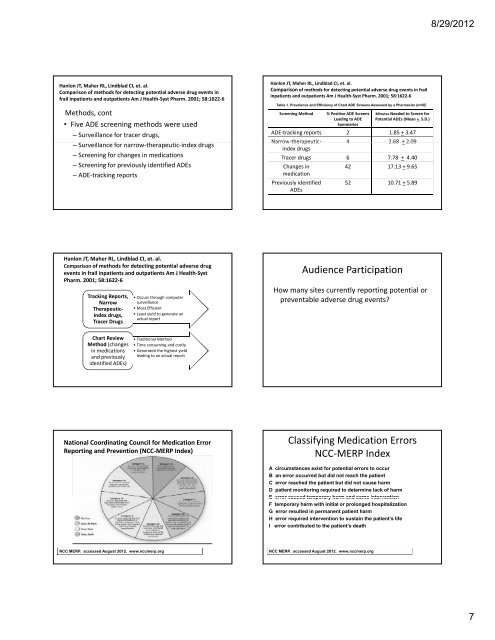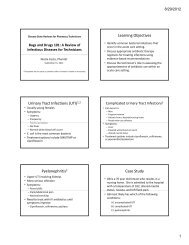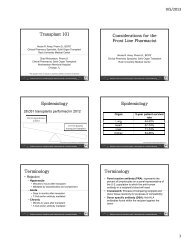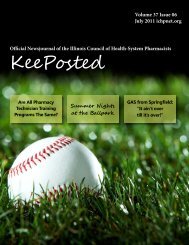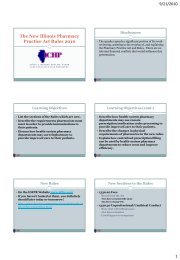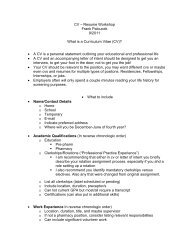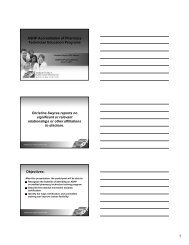Presentation Outline ICHP Annual Meeting September 13-15
Presentation Outline ICHP Annual Meeting September 13-15
Presentation Outline ICHP Annual Meeting September 13-15
Create successful ePaper yourself
Turn your PDF publications into a flip-book with our unique Google optimized e-Paper software.
Hanlon JT, Maher RL, Lindblad CI, et. al.<br />
Comparison of methods for detecting potential adverse drug events in<br />
frail inpatients and outpatients Am J Health‐Syst Pharm. 2001; 58:1622‐6<br />
Methods, cont<br />
• Five ADE screening methods were used<br />
– Surveillance for tracer drugs,<br />
– SSurveillance ill for f narrow‐therapeutic‐index h i i d ddrugs<br />
– Screening for changes in medications<br />
– Screening for previously identified ADEs<br />
– ADE‐tracking reports<br />
Hanlon JT, Maher RL, Lindblad CI, et. al.<br />
Comparison of methods for detecting potential adverse drug<br />
events in frail inpatients and outpatients Am J Health‐Syst<br />
Pharm. 2001; 58:1622‐6<br />
Tracking Reports,<br />
Narrow<br />
Therapeutic‐<br />
Index drugs,<br />
TTracer Drugs D<br />
Chart Review<br />
Method (changes<br />
in medications<br />
and previously<br />
identified ADEs)<br />
• Occurs through computer<br />
surveillance<br />
•Most Efficient<br />
•Least yield to generate an<br />
actual report<br />
•Traditional Method<br />
•Time consuming and costly<br />
• Generated the highest yield<br />
leading to an actual report<br />
National Coordinating Council for Medication Error<br />
Reporting and Prevention (NCC‐MERP Index)<br />
NCC MERP. accessed August 2012. www.nccmerp.org<br />
Hanlon JT, Maher RL, Lindblad CI, et. al.<br />
Comparison of methods for detecting potential adverse drug events in frail<br />
inpatients and outpatients Am J Health‐Syst Pharm. 2001; 58:1622‐6<br />
Table 1. Prevalence and Efficiency of Chart ADE Screens Assessed by a Pharmacist (n=50)<br />
Screening Method % Positive ADE Screens<br />
Leading to ADE<br />
Summaries<br />
Minutes Needed to Screen for<br />
Potential ADEs (Mean + S.D.)<br />
ADE‐tracking reports 2 1.85 + 3.47<br />
Narrow‐therapeutic‐ Narrow therapeutic<br />
index drugs<br />
4 2.68 + + 2.09<br />
Tracer drugs 6 7.78 + 4.40<br />
Changes in<br />
medication<br />
42 17.<strong>13</strong> + 9.65<br />
Previously identified<br />
ADEs<br />
52 10.71 + 5.89<br />
Audience Participation<br />
How many sites currently reporting potential or<br />
preventable adverse drug events?<br />
Classifying Medication Errors<br />
NCC‐MERP Index<br />
A circumstances exist for potential errors to occur<br />
B an error occurred but did not reach the patient<br />
C error reached the patient but did not cause harm<br />
D patient monitoring required to determine lack of harm<br />
E error caused temporary harm and some intervention<br />
F temporary harm with initial or prolonged hospitalization<br />
G error resulted in permanent patient harm<br />
H error required intervention to sustain the patient’s life<br />
I error contributed to the patient’s death<br />
NCC MERP. accessed August 2012. www.nccmerp.org<br />
8/29/2012<br />
7


